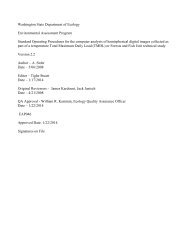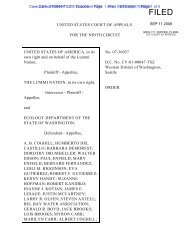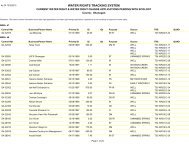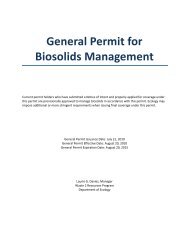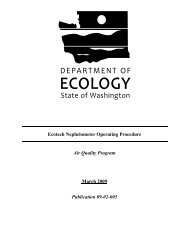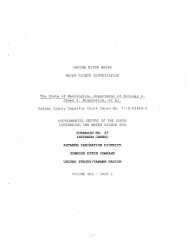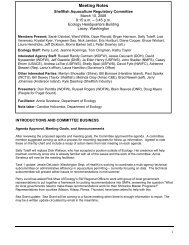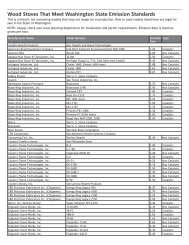WRIA 62 WMP 032305 - Washington State Department of Ecology
WRIA 62 WMP 032305 - Washington State Department of Ecology
WRIA 62 WMP 032305 - Washington State Department of Ecology
You also want an ePaper? Increase the reach of your titles
YUMPU automatically turns print PDFs into web optimized ePapers that Google loves.
March, 2005 -73- 023-1289-003.3040<br />
potential to limit population growth in <strong>WRIA</strong> <strong>62</strong> where domestic exempt wells may be the best<br />
alternative or the only alternative for drinking water supply. The Planning Unit believes that<br />
establishing minimum instream flows to support in-stream needs and to protect senior water rights<br />
while also providing for rural development is a realistic and achievable goal.<br />
The Planning Unit feels that domestic exempt wells are important to support rural development and<br />
population growth in <strong>WRIA</strong> <strong>62</strong>. As a result, the Planning Unit discussed the option <strong>of</strong> making a<br />
recommendation to the Legislature not to condition exempt wells (as defined in RCW 90.44.050) to<br />
instream flows that may be set in the future. This recommendation was strongly supported by some<br />
Planning Unit members and strongly opposed by others. Since the Planning Unit operates by<br />
consensus, this recommendation was removed from the Plan. Further discussion resulted in the<br />
recommendation that in-house domestic use and normal stock watering from domestic exempt wells<br />
drilled after establishment <strong>of</strong> minimum instream flow rules not be restricted by these rules. "In-house<br />
domestic use" means use <strong>of</strong> water for drinking, cleaning, sanitation, and other uses in a residence,<br />
excluding irrigation <strong>of</strong> lawn and garden. The Planning Unit acknowledged that about 70% <strong>of</strong> water<br />
withdrawn by domestic exempt wells may be returned to shallow aquifer systems through a septic<br />
system or via percolation (USGS, 2000). In policy, <strong>Ecology</strong> considers a 50% return flow.<br />
In more rural watersheds such as the Pend Oreille, where public water systems are not available to<br />
many residents, permit-exempt domestic wells are relied upon for most residential water needs. The<br />
Planning Unit has attempted to plan for domestic exempt wells by setting up a framework that will<br />
include evaluating instream flows, and utilizing estimates <strong>of</strong> groundwater and surface water<br />
availability in sub-basins to develop a reservation(s) <strong>of</strong> water (per Chapter 590 WAC) to, in part,<br />
identify future reliable sources <strong>of</strong> water.<br />
Since <strong>Ecology</strong> has closed to further appropriation or placed low-flow restrictions on many <strong>of</strong> the<br />
<strong>WRIA</strong> <strong>62</strong> sub-basins with insufficient stream flow gaging information to support the closures (see<br />
Table 4-1 and Figure 4-3), the Planning Unit discussed the option <strong>of</strong> the Implementing Body<br />
addressing instream flow studies proactively in order to quantify how much water is needed for<br />
instream resources and to determine if additional water is available for future appropriation.<br />
The Planning Unit agreed that if an instream flow study indicates water is available for future<br />
appropriation, that the Implementing Body should consider placing this water within a reservation for<br />
future growth (per Chapter 590 WAC). This reservation, since it is set considering instream flow<br />
needs, would be senior to the instream flow rule and therefore would not be conditioned to the<br />
instream flow. The Planning Unit agreed that it should consider instream flow setting in the subbasins<br />
that are closed to further appropriation or restricted and in the sub-basins that are expected to<br />
experience the greatest population growth. As illustrated on Figure 4-2, these are the Calispell,<br />
Davis, Skookum, Kent and McCloud sub-basins. The types and amount <strong>of</strong> water appropriated in the<br />
reservation would be determined by the Implementing Body based on how the Implementing Body<br />
predicted growth to occur. For example, if growth is expected to occur primarily by domestic exempt<br />
wells, then a reasonable amount <strong>of</strong> water (less than the statutory 5,000 gallon per day allocation and<br />
considering water returns to the ground) would be applied to a domestic exempt well and based on the<br />
water available, a domestic exempt well limit would be set for the geographical area covered by the<br />
reservation.<br />
At such a time when the reservation is close to being allocated, there will be a need to follow a<br />
process to conduct more detailed water availability studies and/or to develop a mitigation framework.<br />
More detailed water supply studies could address: hydraulic continuity between ground water and<br />
surface water; development <strong>of</strong> an alternate water source (such as water withdrawal from a confined<br />
aquifer or withdrawal from the mainstem <strong>of</strong> the Pend Oreille River along with treatment and<br />
<strong>WRIA</strong> <strong>62</strong> <strong>WMP</strong> <strong>032305</strong>



